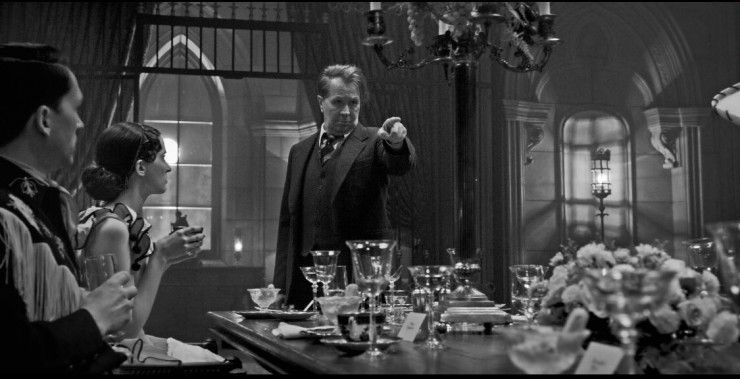
One good way to prepare for change in our own world is to analyze previous societies that were on the precipice of change and how they handled it. What were their successes, or more importantly, their failures in responding to crises that mirror our own? Through these lessons we may be able to better combat the problems of our day.
Mank is the long awaited return to the film for famed director David Fincher, transporting us back to the Golden Age of Hollywood in the 1930s. The film’s namesake Herman J. “Mank” Mankiewicz (Gary Oldman) has just been hired to write the debut film for entertainment wunderkind Orson Welles (Tom Burke) and his new contract with RKO Pictures; a film that would become the iconic Citizen Kane, now widely considered to be the best film ever made. Mank must now race against a two-month deadline to write a film while managing his alcoholism, expectations, and past dustups with Hollywood studio bigshots and the inspiration for the film, newspaper magnate William Randolph Hearst (Charles Dance) that could derail Mank’s big comeback work before it gets off of the ground.
As a film documenting the making of the legendary masterpiece Citizen Kane, Mank is glacially paced, living up to the stereotypes surrounding self indulgent awards fare that Hollywood is roundly criticized for rewarding every winter in haughty black tie ceremonies. Fincher displays his technical prowess as a director, interweaving multiple flashbacks and the current day storyline seamlessly in a way that’s easy to understand and doesn’t disrupt the film’s pacing. For the casual viewer however, Mank may feel too slow; an overindulgent inside joke that takes too long to stir up any sort of drama or reveal itself to be about anything. The story of Mank’s troubles in finishing the script are anticlimactic and lack any emotional pull within the story that allow for the viewer to be invested in the outcome or anxious to see it. His creative process sort of meanders about and isn’t helped by a first hour of the film that is more about setup and backstory than engaging the audience.
Where Mank picks up however and begins to present itself as a film with something interesting to say is in its running subplot that takes place in 1934 during the California Gubernatorial race involving Republican Frank Merriam and famed writer and socialist Upton Sinclair who is running as a Democrat. The subplot gives Mank its topicality, using an older instance of the rich and powerful lamenting the potential rise of socialism and its effect on their power, and most importantly, personal coffers to connect to the world its viewers inhabit in the present. You can’t help but to be reminded of the current progressive movement in the United States and its determination to fight the entrenched class in both the Republican and its own Democratic parties, with Sinclair as a sort of amalgam of U.S. Senator Bernie Sanders (I-VT), “The Squad,” and the modern progressive movement itself. The struggle of an upstart progressive socialist movement that surfaces as the nation manages widespread financial crisis, battling establishment forces on both sides of the political aisle in the midst of the global ascension of authoritarian governments is a story that will resonate with the audience watching the current issues facing the country play out onscreen. In this regard, Mank is reflective of the theory that the best art poses questions about the world around us.
Fincher and director of photography Erik Messerschmidt have crafted standout cinematography particularly with their use of light to create beautiful shadow and illumination of the set and the characters’ sillouettes and shadows. One bit of visual storytelling added by Fincher that is enjoyable for those with a keen eye was the depiction of Orson and Mank’s first meeting. Orson shows up in the hospital dressed in all black with a hat to match, to offer Mank a Faustian bargain as if he is the devil himself; an allusion to a conversation to come and the story at the center of the film. The pair do their best to transport us straight into the time period and are assisted sonically by long time Fincher collaborators Trent Reznor and Atticus Ross as the film’s composers, going outside of their wheelhouse to make a smoky, jazzy score fitting of the times.
Due to a first half that can feel like a chore at times but is full of golden references for hardcore film fans, it is a distinct possibility that Mank could eventually be regarded as an underrated film within cinephile circles, complete with a top selling Criterion edition, and a cult classic among fans of David Fincher. It’s subplot that explores the parallel between the political environment of the mid-1930s California and our current ideological struggles is interesting, but not enough to keep the average viewer engrossed while watching or for repeat viewings. Amanda Seyfried is charismatic as Marion Davies, turning in the film’s best performance, but Gary Oldman is simply suitably good as the film’s lead, missing any of the dynamism that was expected to make this a potential awards vehicle for him. Mank is a well-executed film, appealing visually, and features a notable performance from Seyfried, but it fails to appeal at all as a complete piece of art and is slightly disappointing from what was expected going in.
Image: Netflix

